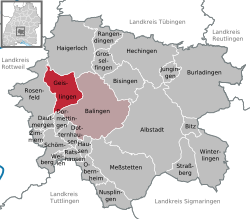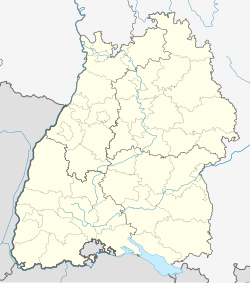world.wikisort.org - Germany
Geislingen is a town in the Zollernalbkreis district of Baden-Württemberg, Germany. It is situated 4 km northwest of Balingen. The population stands at roughly 6,000. Geislingen includes three smaller towns, Geislingen (pop. 4,500), Erlaheim (pop. 500), and Binsdorf (pop. 1,000), all of them growing about 1% per year. The area has been continuously settled since the Stone Age. The first written documentation of Binsdorf came in 834, Geislingen was officially mentioned in 1188. The local economy mixes agriculture with services and small-scale industry. Many residents work in industrial areas south of Stuttgart or in nearby Balingen.
This article may be expanded with text translated from the corresponding article in German. (February 2009) Click [show] for important translation instructions.
|
This article needs additional citations for verification. (September 2007) |
Geislingen | |
|---|---|
Town | |
 Coat of arms | |
Location of Geislingen within Zollernalbkreis district  | |
 Geislingen  Geislingen | |
| Coordinates: 48°17′15″N 08°48′45″E | |
| Country | Germany |
| State | Baden-Württemberg |
| Admin. region | Tübingen |
| District | Zollernalbkreis |
| Subdivisions | 3 Stadtteile |
| Government | |
| • Mayor (2015–23) | Oliver Schmid[1] (Ind.) |
| Area | |
| • Total | 31.95 km2 (12.34 sq mi) |
| Elevation | 563 m (1,847 ft) |
| Population (2020-12-31)[2] | |
| • Total | 5,875 |
| • Density | 180/km2 (480/sq mi) |
| Time zone | UTC+01:00 (CET) |
| • Summer (DST) | UTC+02:00 (CEST) |
| Postal codes | 72349–72351 |
| Dialling codes | 07433 / 07428 |
| Vehicle registration | BL/HCH |
| Website | www.stadt-geislingen.de |
History
In 1764 Carl von Ulm zu Erbach take care by Decretum für das Amt Beeder Herrschaften Werenwag und Callenberg for the Poor.[3] Contributing Textile production. [4] [5] Württemberg planted an alley of fruit trees. (dienstbarkeit). The tree farms of Wilhelm and the Brüdergemeinde provided free fruit.[6] In 1863 those fruits included Luiken, Winterlinge, Fleiner, Knausbirnen, Bratbirnen, Glöcklesbirnen, Fäßlesbirnen, Grunbirnen, Lederäpfel, Breitlinge, Goldparmäne, Rosenäpfel, Zuckerbirnen and Bergamottbirnen. [7]
In 1941, there was a protest against the Nazi Party in Geislingen.[8] [9] In 1990 Erlaheim a fruit tree arboretum was created.[10]
Mining
Sand, sandstone, limestone, gagat, and iron ore were the primary products.[7] The Goldhöhle mine was in Erlaheim near Mildersbach, Schwefelkies, in Geislingen. It later collapsed.[11][12] Binsdorf, had a natural stone quarry. The information panels near the Goldhöhle sponsored by the Kreissparkasse. An old story talks about the Sandmann, a hawker for cleaning sand. The idea was born at the Schwäbischer Albverein in Binsdorf. From a 3.5 km mine in Doggererzflöz in Weilheim is wood in the Tuttlinger Fruchtkasten.[13][clarification needed] Steel was produced in Tuttlingen by the Schwäbische Hüttenwerke in Ludwigshal.
The refinery in Harras was closed in 1832.[14] The long, tedious transport with horses limited the amount of income from pyrite mining in Erlaheim. Economic reforms that allowed the construction of new railways made mining the iron ore of that area unprofitable.[15][16] Near Geislingen, black stone (coal) was mined for Operation Desert (German fuel project) on the road to Erzingen.[17][18] Geislingen was also a center for gagat manufacturing. Gagat is broken in Posidonia Shale.[19][20][21]
Notables
- Michael Sattler, a leader of the Anabaptist movement in the early 16th century, was a prisoner in the tower of Binsdorf[22] before being executed at Rottenburg am Neckar.
- Anna Funk (born in Erlaheim (Erla unter Rosenfeld), died 1587) not guilty in fire as witch[23][24]
References
- Schmid für weitere acht Jahre gewählt, Schwarzwälder Bote, 21 September 2015.
- "Bevölkerung nach Nationalität und Geschlecht am 31. Dezember 2020" [Population by nationality and sex as of December 31, 2020] (CSV). Statistisches Landesamt Baden-Württemberg (in German). June 2021. Retrieved 17 October 2021.
- Monika Spicker-Beck (2019), Sigrid Hirbodian; Andreas Schmauder; Manfred Waßner (eds.), "Eine Stadt im Wandel der Zeit", Gemeinde Im Wandel (in German), vol. 19, pp. 164f, ISBN 978-3-00-064226-5
- Carl von Ulm (1754), "Decretum für das Amt Beeder Herrschaften Werenwag und Callenberg", Landesarchiv Baden-Württemberg, Hauptstaatsarchiv Stuttgart, Archivarieneinheit B 38 (in German), vol. B 38 Bü 5
- Hermann Krauß, "Aus früherer Zeit: Armut, Bettelunwesen, Armenfürsorge", Gemeindearchiv Meßstetten, Bestand T1-2165 (in German)
- "Apfelgeschichte auf Apfelgut Sulz" (PDF). Archived from the original (PDF) on 2020-09-29. Retrieved 2018-03-30.
- "Beschreibung des Oberamts Sulz/Kapitel A 5 – Wikisource". de.wikisource.org.
- "Weiberschlacht". Schwarzwälder Bote (in German). 2017-10-12. Retrieved 2017-08-11.
- Weiberschlacht
- Germany, Schwarzwälder Bote, Oberndorf. "Geislingen: Bürgerverein unterwegs auf dem Obstlehrpfad - Schwarzwälder Bote". www.schwarzwaelder-bote.de.
- Germany, Schwarzwälder Bote, Oberndorf. "Geislingen: Keine Reichtümer im Goldloch - Schwarzwälder Bote". www.schwarzwaelder-bote.de. In: Schwarzwälder Bote, 20.08.2015.
- Oberamtsbeschreibung Balingen
- "Lokale Bergbaugeschichte im Fruchtkasten - Neue Exponate erinnern an Erzabbau | Stadt Tuttlingen". www.tuttlingen.de. In: Pressemiteilungen. 21.November 2016.
- memminger, Jahrbuch 1839 (in German), p. 352
- Friedrich von Alberti, Die Gebirge des Königreichs Württemberg, in besonderer Beziehung auf Halurgie (in German), Stuttgart und Tübingen: J. G. Cotta’sche Buchhandlung 1826, p. 124
- Germany, Schwarzwälder Bote, Oberndorf. "Hechingen: Eisenindustrie als Sozialprogramm - Schwarzwälder Bote". www.schwarzwaelder-bote.de. In: Schwarzwälder Bote, 28.09.2016.
- Germany, Schwarzwälder Bote, Oberndorf. "Balingen: KZ Natzweiler bewirbt sich um Kulturerbesiegel - Schwarzwälder Bote". www.schwarzwaelder-bote.de. In: Schwarzwälder Bote. Zollernalb, 24. April 2017.
- Germany, Schwarzwälder Bote, Oberndorf. "Balingen: Denkmalamt nimmt sich KZ-Geschichte an - Schwarzwälder Bote". www.schwarzwaelder-bote.de.
- Bestand B40 Bü1240 auf Landesarchiv-BW.de
- Sigrid Hirbodian; Andreas Schmauder; Manfred Waßner, eds. (2019), Die Geschichte von Meßstetten: Eine Stadt im Wandel, Gemeinde im Wandel 19 (in German), p. 198
- Siegfried Kurz, Bestattungsbräuche in der westlichen Hallstattkultur (in German), p. 171
- Werner-Ulrich Deetjen (1985), 700 Jahre Stadt Ebingen - Geschichte in Bildern Vorträgezur Geschichte: Das Reich Gottes zu Ebingen-Gedanken zu seiner Geschichte und Eigenart (in German), Albstadt: Druck und Verlagshaus Daniel Balingen
- Hegeler, Hartmut. "Namen der Opfer der Hexenprozesse/ Hexenverfolgung in Rottweil" (PDF). Retrieved Mar 17, 2018.
- "Rottweils Hexen und Zauberer werden rehabilitiert". NRWZ.de (in German). Archived from the original on 2015-05-25. Retrieved 2018-03-17.
На других языках
- [en] Geislingen, Zollernalbkreis
[ru] Гайслинген (Балинген)
Гайслинген (нем. Geislingen) — город в Германии, районный центр, расположен в земле Баден-Вюртемберг.Другой контент может иметь иную лицензию. Перед использованием материалов сайта WikiSort.org внимательно изучите правила лицензирования конкретных элементов наполнения сайта.
WikiSort.org - проект по пересортировке и дополнению контента Википедии
